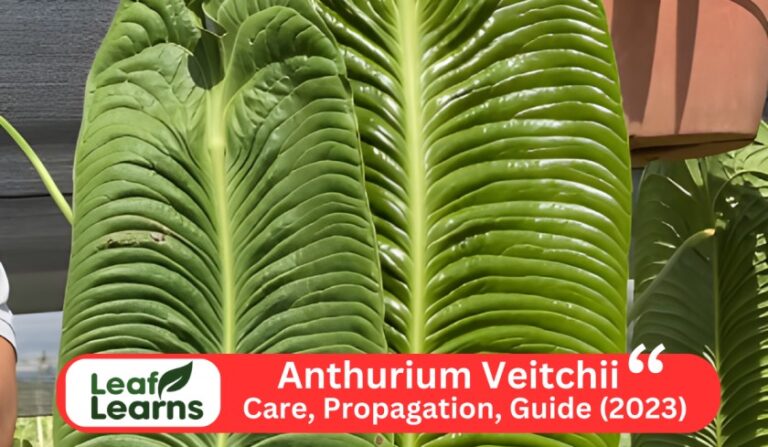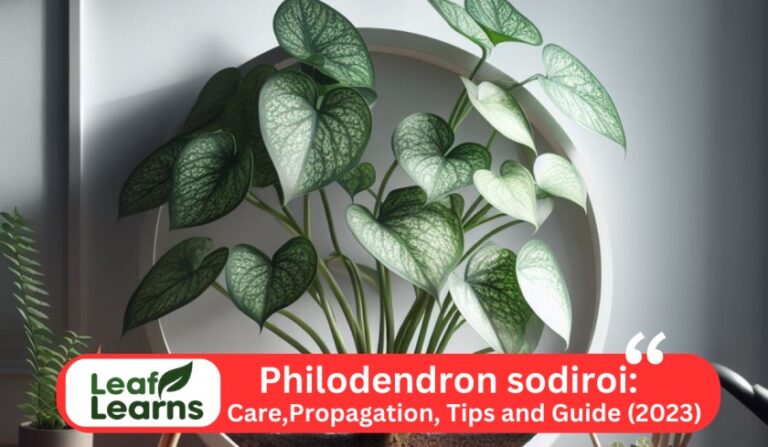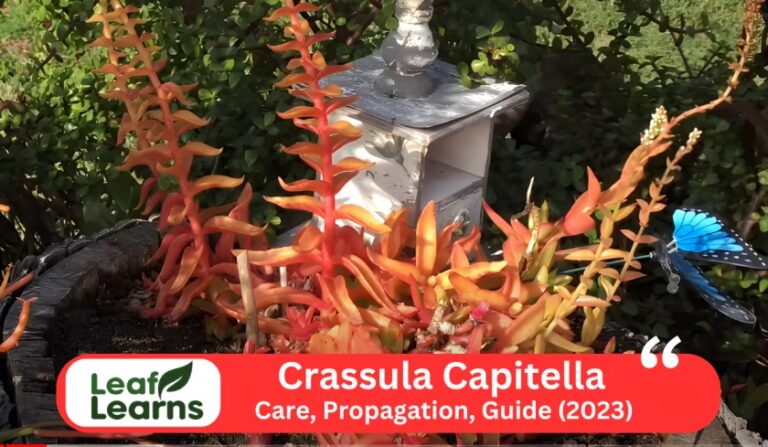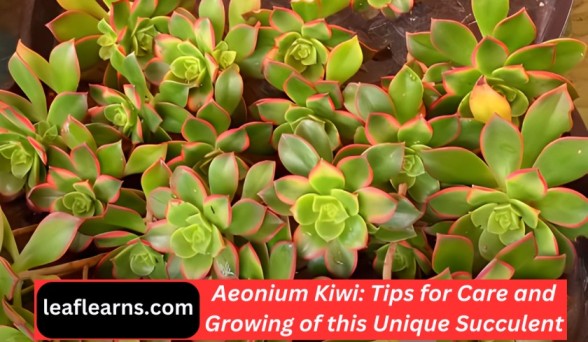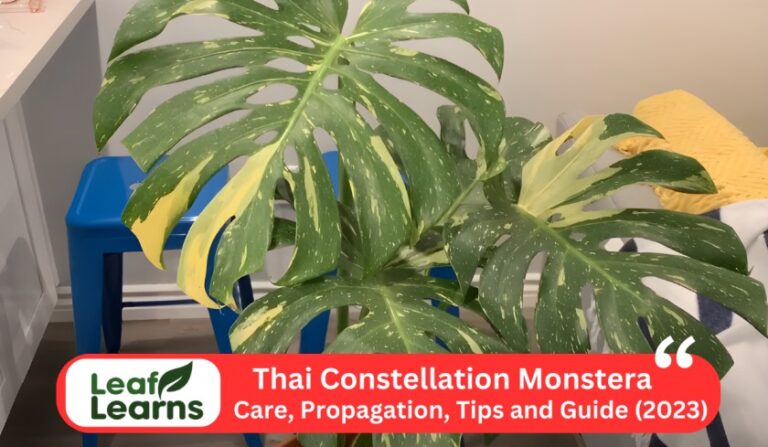Philodendron Erubescens: Care, Grow, Tips and Guide (2023)
The Red-Leaf Philodendron scientifically called Philodendron Erubescens. This plant belonging to the Araceae family. And this originate form the Central and South America. This Plant is perennial and show a very tall height reaching up to 3 – 6 feet (0.9-1.8 meters). This plant show dark green leaves with burgundy undersides that can reached lengths of up to 40 cm (16 in).
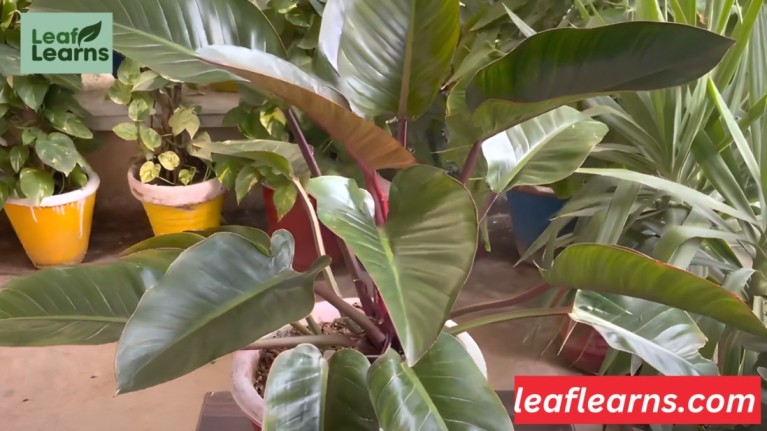
To Best grow , it can requires temperatures between 65-80°F (18-27°C) and It needs high humid environment Like more than 60%. It is very necessary to note that this plant is very high toxic to human and pets both. For its proper growth, it needs bright, indirect sunlight and well-draining soil.
Keep it hydrated but need the soil to partially dry between watering. Mealybugs and spider mites are the main pests for philodendron erubescens. The most important propagation methods is stem cutting and air layering and its charming red or blush-colored flowers it is very beautiful plant for the indoor spaces.
| Common name | Red-Leaf Philodendron |
| Scientific Name | Philodendron-Erubescens |
| Family | Araceae |
| Distribution | Central and South America |
| Plant type | Perennial |
| Size | Up to 3-6 feet (0.9-1.8 meters) |
| Leaf Colour | dark green and burgundy |
| Leaf size | up to 40 cm (16 in) in length |
| Temperature | 65-80°F (18-27°C) |
| Humidity | High, prefers humidity |
| Toxicity | Toxic to humans and pets |
| Light requirement | Bright, indirect sunlight |
| Soil requirement | Well-draining potting mix |
| Watering Need | Allow soil to partially dry between waterings |
| Propagation | Stem cuttings, air layering |
| Flower colour | red or blushes |
| Pests | Mealybugs, spider mites |
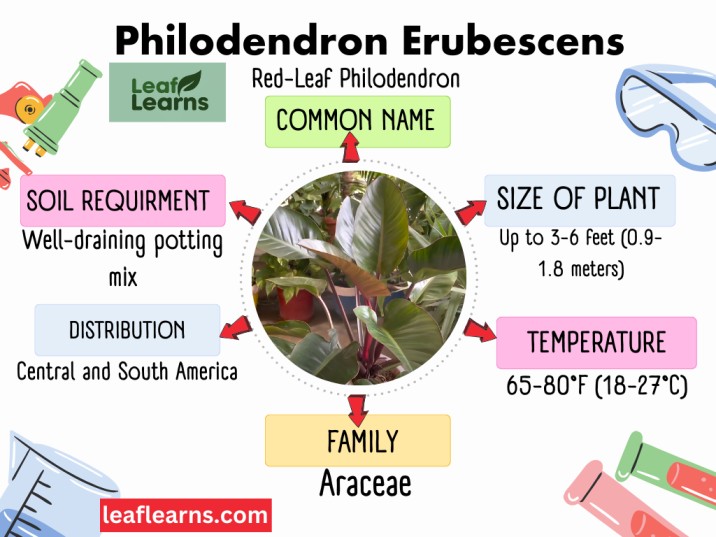
Contents
- 1 Top Care Tips
- 2 What’s Unique About Philodendron-Erubescens?
- 3 Care for Philodendron Erubescens
- 4 Pruning
- 5 Growth Rate and Size
- 6 Propagating Philodendron Erubescens
- 7 How to Grow Red-Leaf Philodendron From Seed
- 8 Repotting Philodendron Erubescens
- 9 Flowering and Foliage
- 10 Overwintering
- 11 Common Pests
- 12 Plant Diseases
- 13 How to Get Red-Leaf Philodendron to Bloom
- 14 Problems and Solutions
- 15 Toxicity of Philodendron Erubescens
- 16 Philodendron Erubescens Appearance
- 17 Suggested Uses
- 18 Caring for Philodendron-Erubescens: Tips for a Thriving Plant
- 19 The Versatile Philodendron-Erubescens: Types and Uses in Interior Decor
- 20 Conclusion
- 21 FAQs
Top Care Tips
- To preserve its bright leaves, place in bright, indirect sunshine.
- Water sparingly, letting the top inch of the soil dry before applying more water.
- Make sure the soil is well-draining to avoid root rot.
- Keep humidity levels high, particularly in dry indoor areas.
- To encourage healthy development, fertilise once a month during the growing season.Mealybugs and spider mites are two typical pests to watch out for.
- Remove any damaged or discoloured leaves and prune the plant to promote bushier growth.
- To multiply your plants, use stem cuttings or air layering.
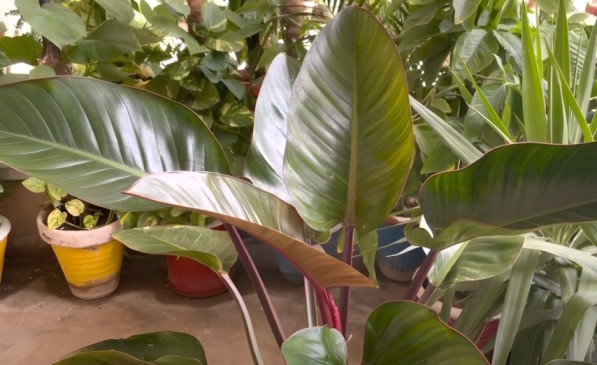
What’s Unique About Philodendron-Erubescens?
The Red-Leaf Philodendron is distinguished for its exquisite leaves. Its leaves have a striking two-tone appearance with glossy green on top and bright scarlet or burgundy underneath.
It is a distinctive and eye-catching addition to any collection of indoor plants because of its vivid hue. Its air-purifying capabilities further contribute to its allure, making it attractive and advantageous for indoor air quality.
Care for Philodendron Erubescens
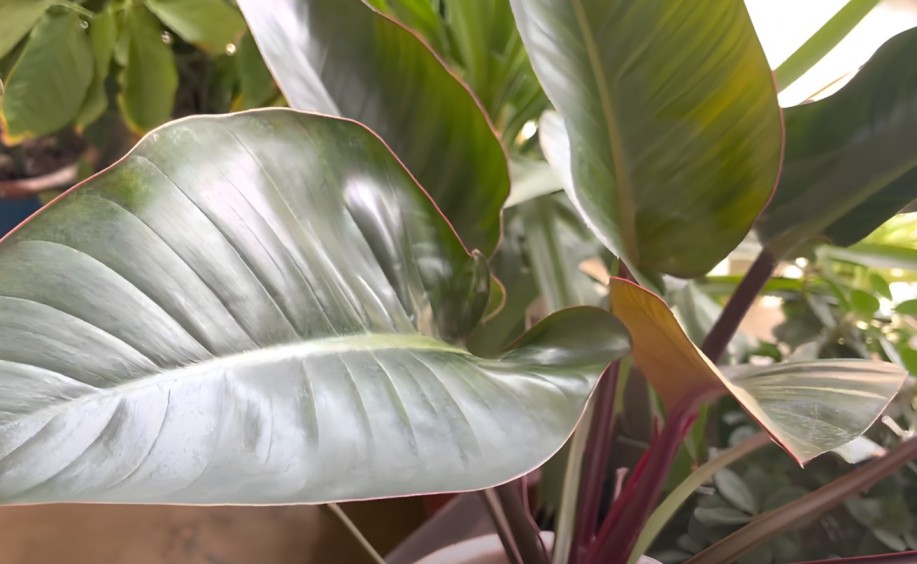
Light Requirement
When you comprehend the Red-Leaf Philodendron light requirements, caring for it is simple. Bright, indirect sunshine is preferred by this plant.
Put it somewhere near a window where the sun’s rays won’t directly hit the foliage. It thrives in this soft light, which also keeps the colour of its leaves. Avoid direct sunlight since it will burn the foliage.
Remember that giving your Red-Leaf Philodendron the ideal light is like giving it the ideal area for tanning, keeping it happy and healthy. So success depends on strong, indirect sunshine!
Water Requirement
It’s simple to water a Philodendron-erubescens. Consider it this way: They want a brief period of dry time in between drinks. Before giving them a drink, let the top inch of the soil dry off.
In order to determine whether the soil needs watering, stick your finger into it. Be thorough but not drenched while handling water. Ensure that any extra water can drain.
Remember that they loathe wet roots and would like to be slightly underwatered rather than overwatered.
Soil Requirement
When it comes to soil, Philodendron-Erubescens is simple to care for. This plant loves soil that drains well, thus the soil should make it simple for extra water to evaporate.
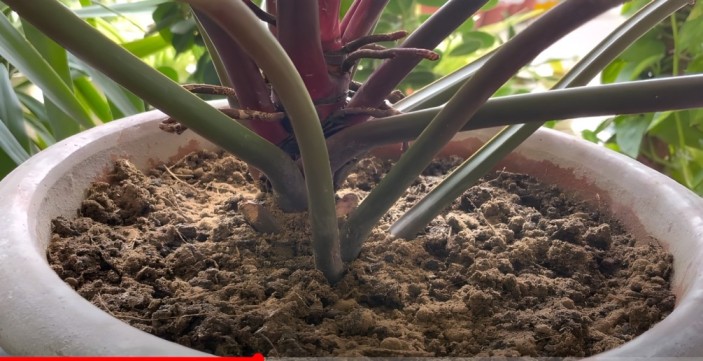
The solution is to use potting soil that has been expressly labelled as “well-draining” or to incorporate perlite into conventional potting soil. This kind of soil helps to keep the plant healthy by preventing root rot.
In order to maintain the health of your Red-Leaf Philodendron, always wait until the top inch of the soil has dried up before watering it again.
Temperature Requirement
Consider the demands of your Philodendron-erubescens with regard to temperature. The ideal temperature range for this plant is between 65 and 80 °F (18 and 27 °C).
That’s similar to a cosy room for you. Avoid extremes that might stress the plant, such as bitter cold draughts and sweltering heat.
Your Red-Leaf Philodendron will flourish if you can give it this ideal amount of warmth, according to Goldilocks, and display its stunning leaves. Keep in mind that a happy plant means a happy temperature!
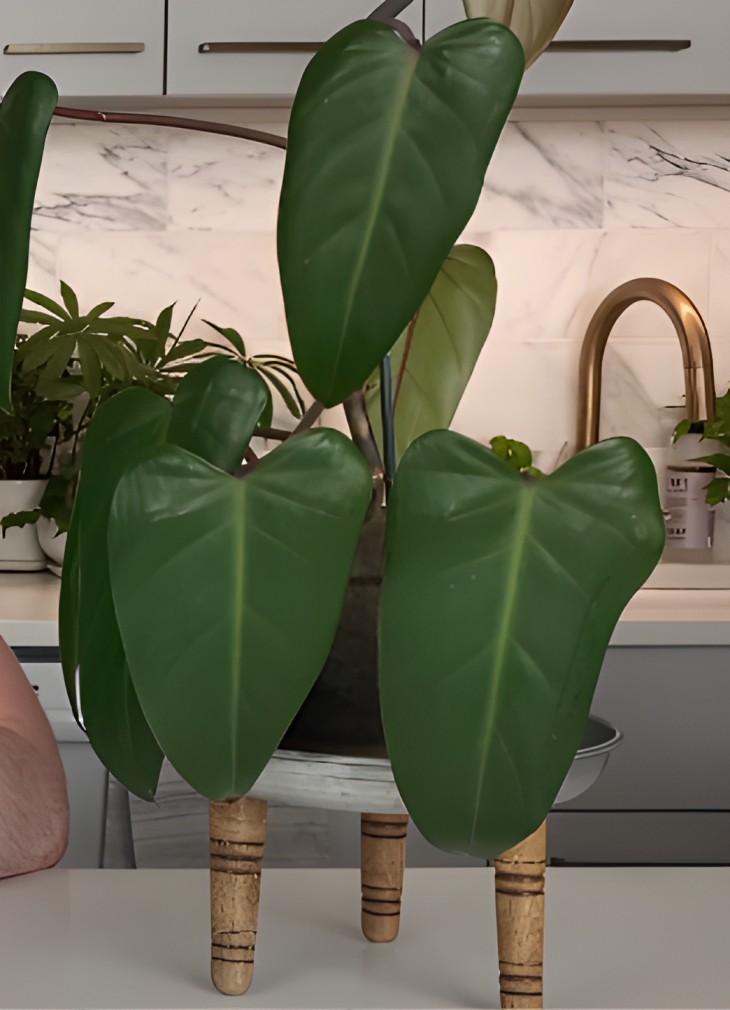
Humidity Requirement
Understanding the demands of Red-Leaf Philodendron in terms of humidity is essential for proper care. Because it enjoys dampness, this plant does best in humid environments.
Regularly sprinkle its leaves or put it next to a humidity tray with water to keep it content. Consider using a humidifier if the air inside your home is dry.
This additional moisture stops your Red-Leaf Philodendron from developing crispy leaf edges and keeps it looking lush and alive, making it simple to maintain in any home or office environment.
Fertilizer Requirement
It is simple to take care of Philodendron-erubescens, and fertilizer is essential. Apply a balanced liquid fertilizer to this wonderful plant once a month throughout the growing season to maintain its health.
Think of it like providing it with a healthy supper. But keep in mind, don’t overeat! Your philodendron may suffer if you use too much fertilizer.
Keep to the timetable and see it flourish with bright leaves by doing so. It’s similar to giving your plant the ideal quantity of nourishment to keep it healthy and attractive.
Potting Requirement
Red-Leaf Philodendron maintenance is simple, especially when it comes to potting. To keep your plant healthy, choose a potting mix that drains properly. To avoid water collecting at the bottom, make sure the pot has drainage holes.
When repotting, use a container with a diameter that is one to two inches bigger than the existing one. Keep in mind that this plant like to be a little bit tight in its pot.
Refrain from overpotting since it may impede growth. Your Red-Leaf Philodendron will thrive in the right environment if you pot it properly, which guarantees excellent drainage.
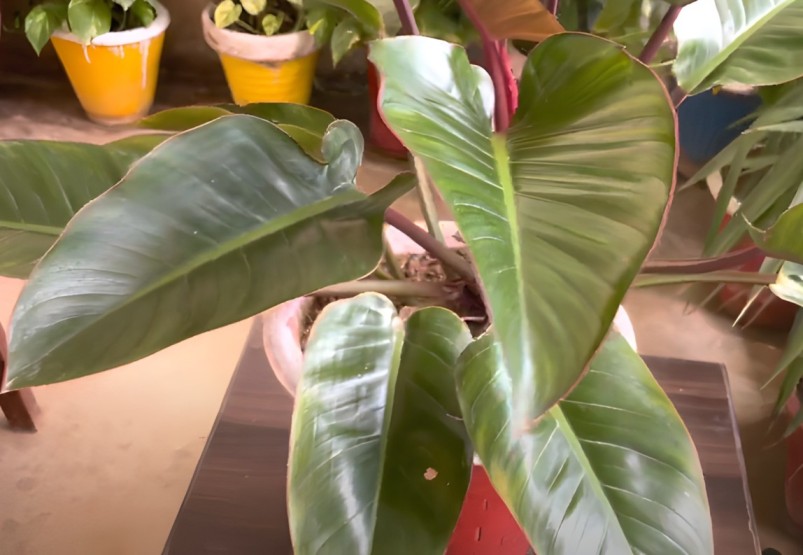
Pruning
To maintain your Philodendron-Erubescens healthy and looking its best, pruning is similar to giving it a haircut. Clean pruning shears or scissors should be used to remove any yellow or broken leaves.
This aids the plant’s concentration on developing fresh, colourful leaves. Alternatively, you may trim the ends off longer stems to create a bushier form.
To prevent sickness, be careful not to cut yourself too deeply and always use clean instruments. Your Red-Leaf Philodendron will remain flourishing and aesthetically pleasing with routine trimming.
Growth Rate and Size
The Red-Leaf Philodendron grows slowly, so it won’t suddenly soar to great heights but it also won’t remain little forever. When completely grown, it normally has a height of 3 to 6 feet (0.9 to 1.8 metres).
Think of it as a patient, steady plant friend that develops into a pretty, medium-sized houseplant. It won’t encroach on your area, but its bright red and green foliage will still add a charming presence.
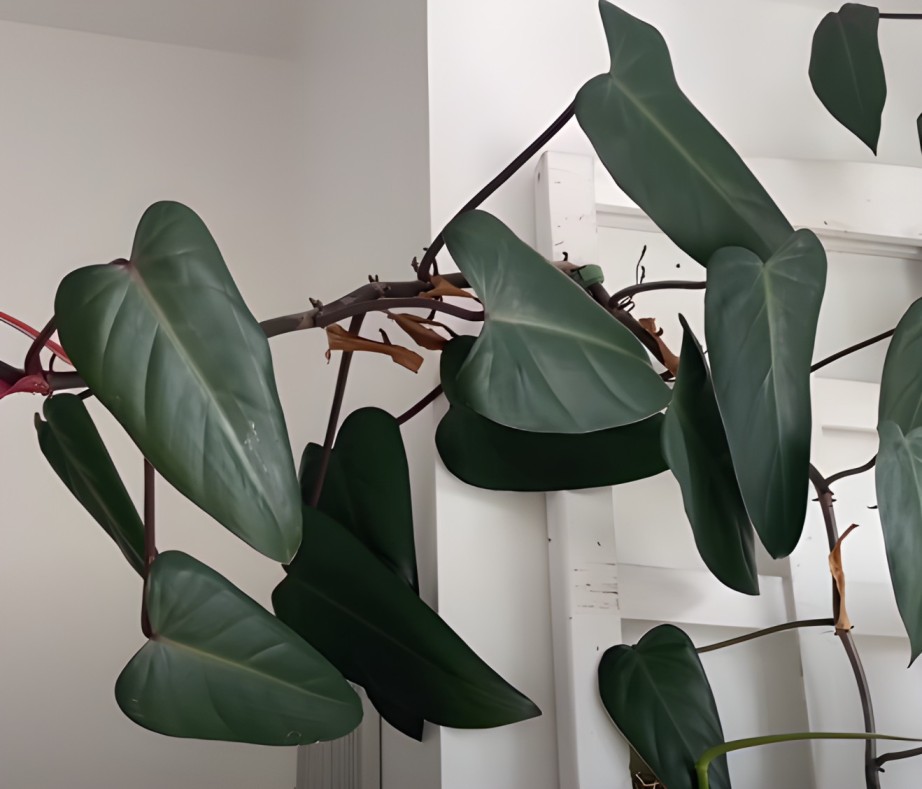
Propagating Philodendron Erubescens
Stem Cuttings
- Pick a stem that is healthy and has a few leaves.
- Cut a 4-6 inch (10-15 cm) portion of the stem right below a leaf node (where leaves are joined) using clean, sharp scissors or pruning shears.
- To reveal a node, remove any leaves close to the bottom.
- A callus will form on the cutting after an hour of air drying, helping to stop rot.
- Bury the node in the soil and leave the remaining portion of the cutting exposed while planting the cutting in a well-draining potting mix.
- Keep the soil continually wet and place in a bright, indirect area of light.
- In a few weeks to a few months, roots will start to form.
Air Layering
- Choose a healthy stem and cut it halfway through at a 2-3 inch (5-7.5 cm) interval.
- If available, apply rooting hormone to the cut region.
- With damp sphagnum moss or another rooting media, wrap the cut part.
- Plastic wrap or a plastic bag should be used to enclose and hold the moss in place.
- Consistently mist the moss.
- In a few weeks to a few months, roots should begin to develop.
- Cut the stem below the rooted part after roots are well-established, and then put it in a container.
Division (for mature plants)
- Remove the Red-Leaf Philodendron with care from the pot.
- Make sure each component of the plant has sound roots and leaves before carefully dividing it into two or more halves.
- Plant each segment in a separate container with new potting soil.
- Place in direct light that is bright after completely watering.
- As the new plants grow and establish themselves, give them regular watering and attention.
How to Grow Red-Leaf Philodendron From Seed
Gather seeds from a mature this plant. The seeds are often located in the spadix inside the flower.
Seed Preparation: To soften the seed coat, soak the seeds in warm water for 24 hours.
Plant the seeds in a little container filled with potting soil that drains nicely. Spread the seeds thinly, at a depth of about 1/4 inch.
Maintain regular soil moisture without letting it get saturated. To produce the appearance of a little greenhouse, cover the pot with plastic wrap or a plastic lid.
Place the pot in a warm, well-lit spot that receives indirect sunshine. Keep the temperature between 70 and 80 °F (21-27 °C).
It may take weeks or months for seeds to germinate. Be patient and continuously moisten the soil.
Transplant: Once the seedlings are large enough to handle, transplant them into individual pots with well-draining soil.
Repotting Philodendron Erubescens
The Philodendron-Erubescens is simple to repot, however keep in mind that it prefers bright light. Choose a little larger pot with adequate drainage when it’s time to repot.
Remember that this plant prefers bright, indirect light, so after repotting, choose a location that fits those requirements.
Then, carefully move it to its new location, being careful not to too disrupt the roots. Your Red-Leaf Philodendron will thrive in the proper container and with the right light!
Flowering and Foliage
Not its blooms, but Red-Leaf Philodendron beautiful foliage is its claim to fame. Its leaves have a glossy green top and a bright scarlet underside, which contrasts well.
Give these leaves strong, indirect light to keep them looking their best. Indoor plants seldom ever blossom, but they could in the wild produce tiny, unnoticeable blooms. So, savour its intriguing foliage and keep in mind that this plant is all about the leaves!
Overwintering
Take into account the Red-Leaf Philodendron light requirements when overwintering it. It enjoys light significantly less in the winter than in the summer.
Place it close to a window with good light, but keep it out of direct sunlight.
This keeps it healthy during the winter months. Imagine it as a warm winter jumper that is just the right amount of light to keep you comfortable without being too hot.
Common Pests
It is essential for the health of your Philodendron-Erubescens to keep it free from frequent pests. If the plant doesn’t receive enough light, parasites like mealybugs and spider mites can enter.
It becomes weaker and more prone to infestations when exposed to low light over an extended period of time. So, by giving your plant the correct bright, indirect sunlight it needs, you can ensure its strength and pest-free status. It’s as if you gave it a built-in defence shield!
Plant Diseases
If the light requirements of this plant are not satisfied, issues may result. Leggy growth and lifeless leaves might result from inadequate lighting.
However, excessive exposure to direct sunlight can burn the leaves. Like Goldilocks, it need the ideal quantity of light to survive and grown neither too much nor too little.
Therefore, achieving the ideal balance of light is essential for avoiding plant problems.
How to Get Red-Leaf Philodendron to Bloom
Light is the key to causing this plant to blossom. This plant tends to develop thick leaves rather than flowers, which might be uncommon indoors.
Consider giving blossoms with bright, indirect sunshine. It’s like giving it a jolt of inspiration. Though this philodendron is more well-known for its foliage than for its flowers, don’t be disappointed if it doesn’t bloom regularly.
Concentrate on the lush vegetation instead, and the few blossoms will come as a welcome surprise.
Problems and Solutions
Problem: Yellowing Leaves
Solution: To avoid overwatering, check the moisture level of the soil, water sparingly, and ensure appropriate drainage.
Problem: Leggy Growth
Solution: To promote bushier growth, prune lengthy stems, and turn the plant to provide an even distribution of light.
Problem: Pest Infestation (e.g., mealybugs)
Solution: Put the plant in isolation, exterminate bugs by hand, and then use insecticidal soap or neem oil as necessary.
Problem: Dull Foliage
Solution: To eliminate dust and let the leaves to breathe and shine, gently wipe them with a moist cloth.
Problem: Lack of Blooms
Solution: Assuring strong, indirect sunshine will help encourage sporadic flowering while emphasising the rich foliage.
Toxicity of Philodendron Erubescens
If consumed Red-Leaf Philodendron, also known as Red-Leaf Philodendron, can be dangerous. Keep inquisitive dogs and young children away from it at all costs.
It is advised to avoid tasting the plant because it contains ingredients that might upset your stomach. To be safe, take a step back and take in its beauty while washing your hands after handling it. Although it’s beautiful to look at, it’s not meant to be eaten.
Philodendron Erubescens Appearance
It’s hard to deny the Red-Leaf Philodendron’ beauty! Its leaves have a brilliant crimson or burgundy colour on the underside and glossy green on top, as if they had been polished. What distinguishes it is the two-tone appearance.
Imagine it dressed in fashionable, vibrant attire. It transforms your living environment into a natural piece of art by adding a touch of elegance. It stands out from other plants thanks to its distinctive look.
Suggested Uses
It is a beautiful indoor plant that will provide a bit of nature’s beauty to your living room, bedroom, or workplace.
Hanging Baskets: To create a classy presentation, let its trailing tendrils pour forth from hanging baskets.
Use it as a natural air purifier to enhance the air quality in your home or place of business.
Green Walls: To create a gorgeous living wall feature, incorporate it into a vertical garden or green wall.
Its distinctive red-tinged leaves make it an appealing option for ornamental reasons in flower arrangements or bouquets. ornamental Foliage.
Caring for Philodendron-Erubescens: Tips for a Thriving Plant
Caring for a Philodendron-Erubescens involves providing it with the right conditions to thrive. To care for this beautiful plant, ensure it receives bright, indirect sunlight. Avoid direct sunlight, as it can scorch the leaves. Water your plant thoroughly but allow the top inch or so of the soil to dry out between waterings. Overwatering can lead to root rot, so it’s essential to strike the right balance.
Propagation of Philodendron-Erubescens can be done through stem cuttings. Simply snip a healthy stem with at least one node, place it in water until roots develop, and then transplant it into a well-draining potting mix. Regularly prune your plant to maintain its shape and remove any dead or yellowing leaves.
Red-Leaf Philodendron is a versatile plant used for decorative purposes in homes and offices, thanks to its elegant foliage. Its heart-shaped leaves and vibrant green color make it a popular choice for interior décor.
This plant comes in various varieties, each with its unique characteristics and colors, such as the ‘Pink Princess’ Philodendron and ‘Red Heart’ Filodendron, adding diversity to its uses in different settings.
The Versatile Philodendron-Erubescens: Types and Uses in Interior Decor
Proper care and maintenance include regular watering, with the frequency depending on factors like humidity, temperature, and the potting mix used. Philodendron-Erubescens generally thrives in well-draining soil, so ensure your potting mix allows excess water to escape.
Fertilize your plant during the growing season to provide it with essential nutrients for healthy growth. While this plant is a beautiful addition to any space, it’s crucial to remember that it can be toxic to pets like cats and dogs, so ensure it’s placed out of their reach.
By following these care guidelines and understanding the different types and uses of Philodendron-Erubescens, you can enjoy the beauty of this plant while keeping it happy and healthy in your home.
Conclusion
In conclusion Red-Leaf Philodendron, care is simple and satisfying. For its brilliant foliage, provides indirect sunshine, moderate watering, well-draining soil, and humidity maintenance.
It is kept healthy by monthly fertilization, vigilant insect control, and sporadic trimming. It may be spread by air layering or stem cuttings.
Its distinctive look, ability to filter the air, and ornamental potential make it the perfect interior plant but use caution because it is harmful to both people and animals. Safeguard your safety while admiring its beauty!
FAQs
What is the unique feature of Philodendron erubescens ?
It is distinctive for its eye-catching two-tone foliage, which has glossy green leaves on top and vivid scarlet or burgundy undersides.
What is the recommended light condition for Philodendron Erubescens?
It should avoid strong, direct sunlight and loves bright, indirect light.
How should you water Philodendron Erubescens?
Water it sparingly, letting the top inch of soil dry up before providing further moisture. To avoid soggy roots, don’t overwater the plants.
What type of soil is best for Philodendron Erubescens?
It does best in soil that drains well, which may be accomplished by using a well-draining potting mix or by adding perlite to ordinary potting soil.
What temperature range is ideal for Philodendron Erubescens?
It should be shielded from freezing draughts and intense heat as it enjoys temperatures between 65 and 80 degrees Fahrenheit (18 and 27 degrees Celsius).
How can you maintain the right humidity for Philodendron Erubescens?
Its leaves may be periodically misted, or you can use a humidity tray with water. Using a humidifier could be a good idea if the air inside is dry.
How often should you fertilize Philodendron Erubescens?
During the growth season, fertilize it with balanced liquid fertilizer about once a month.
What is the recommended method for propagating Philodendron Erubescens?
To grow new plants, you can propagate it by taking stem cuttings or air layering.

